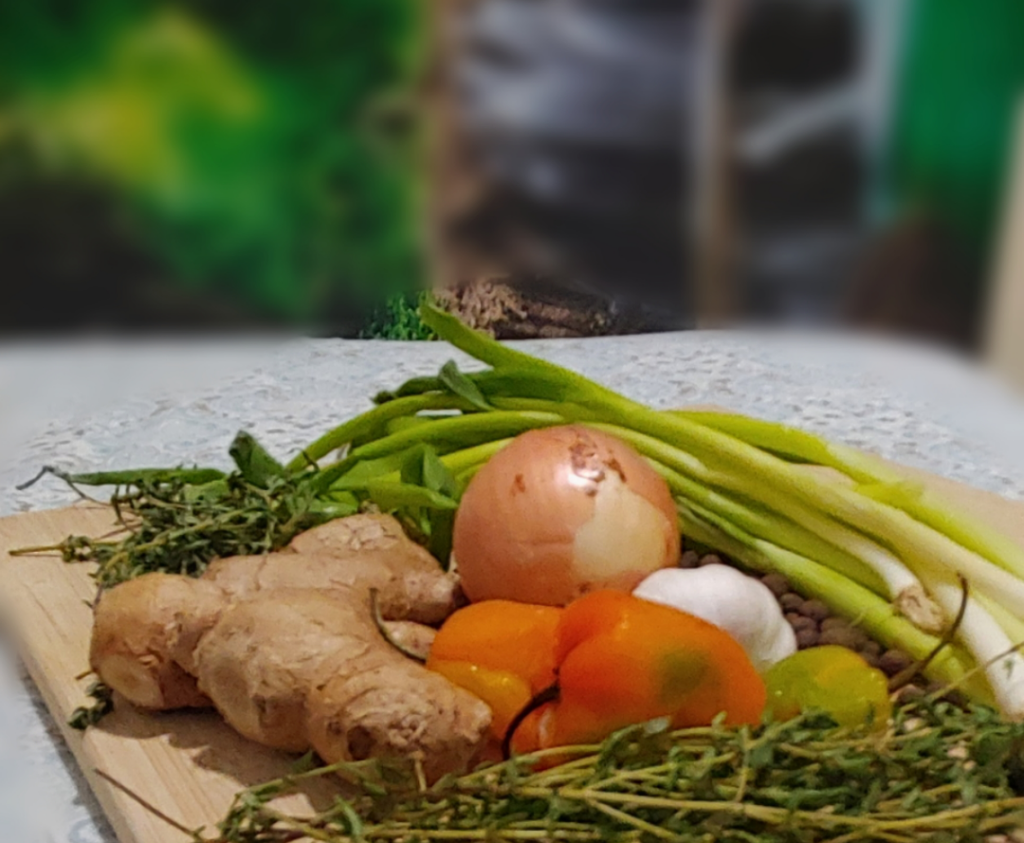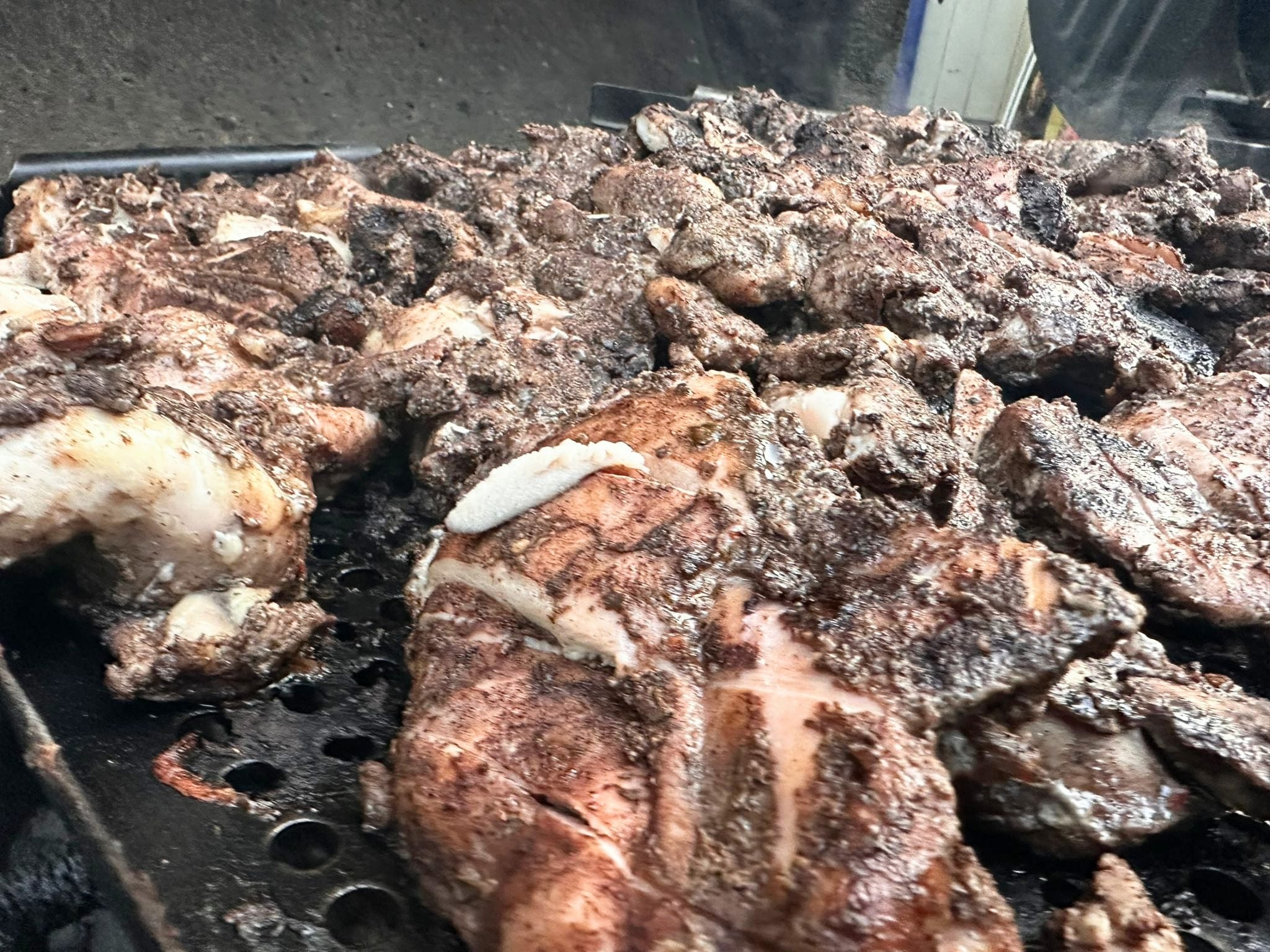Evolution of Jerk from Jamaican Ancestors to What We Know it as Today

The full-bodied and flavorful taste of Jamaican Jerk either as a cooking style or an added seasoning is a must-try item, even once in your life.
Jerk is one of Jamaica’s most renowned culinary styles and flavors, which has evolved over many generations. The rich blend of selective Jamaican herbs and spices brings about a rich flavor that can be tasted right down to the inner core of the meat or the sauce of the meal. Moreover, the juicy, smoky, and mouth-watering taste of a piece of meat cooked to perfection using the jerk cooking style, keeps you wanting more. This highlights the uniqueness of jerk as it is not only a style of cooking but also an ingredient that can be used to add an extra spice to almost any dish, or a delectable combination of both.
(Photo to the left Caption: The foundational ingredient of any jerk seasoning includes peppers, onions, green onions, pimento seeds\all spices, garlic, thyme, and ginger (Haughton, August 2023))
Where did it Originate?
Jerk is a fusion of Jamaica’s indigenous peoples the Tanios\ Arawak Indians who were enslaved under Spanish colonization and the Africans who were enslaved under British colonization. Most of the Tanios fled to the mountains when the British took over, and many enslaved Africans took to the mountains for freedom from British dictatorship. These mountaineers are referred to as the Maroons.
In the name of survival, the Maroons had to be discreet even in their cooking method to keep their location unknown from the British. Maroons would hunt animals usually pigs, then season the meat with a blend of peppers, thyme, scallion, onion, garlic, ginger, and pimento seeds – referred to as jerk seasoning.
The meat is then placed over an underground smoke pit lined with pimento wood and slow-cooked to perfection. The seasoning allows the meat to have a flavourful and spicy taste. While the smoke acts as a preservative but also plays an integral role in combining the flavor of the seasoning, with the smoked pimento wood, to bring about a complex yet delicious meal
Evolution of Jerk – Cooking Style

Over the years the style of a cooking jerk has evolved, as the underground fire pit with the pimento wood is replaced with steel drum jerk pans. Also, the meat is not smoked for as long as we have other methods of food preservation.
Furthermore, in hope of better opportunities, many Jamaicans migrate to foreign lands such as the USA and Canada where smoke pits nor steel pans are not readily available. Their yearning for a taste of home propels them to become creative with their cooking style. Giving birth to the method of jerking on propane grills.
The shift in the cooking method of jerk triggers consequential importance for jerk seasoning, as propane grill fails to provide that authentic smokiness. Therefore, the seasoning is needed to bring about that ‘jerk’ taste that may not be as authentic but is as close to home as you can get.
Evolution of Jerk – Seasoning
Additionally, over the years Jerk Seasoning has also become commercialized and expanded to have both dry and wet jerk seasoning, along with a variation of spice levels. Popular jerk brands include Walkerswood, Grace, and Cool Runnings.
The key ingredients of jerk seasoning have remained relatively constant over time, one ingredient that might change is the use of pepper. Traditionally bird pepper was used, then scotch bonnet pepper became the pepper of choice. For people living overseas habanero pepper, chili pepper. cayenne pepper or chili powder may be the best alternatives. Likewise, some people may opt to add sugar or lime/lemon juice to reduce the spicy level. Other ingredients that have been added over time include nutmeg for flavor, browning for that dark color, vinegar for flavor, liquid or preservative.
Jerk as we know it today!
Necessity and curiosity are two traits that will lead to evolution. This is the same with the evolution of jerk over the years. The necessity of Jamaican living abroad to find jerk ingredients, along with curiosity to try new cooking methods has led to jerk having three distinct associations a cooking style, a seasoning, or a combination of both. Because of these modern associations, we now see many dishes being classified as jerk not because it was cooked in the ways established by the Marrons, but rather because it was cooked using a jerk pan\grill, or used a significant amount of jerk seasoning, or a combination of both.
e.g. jerk lobster, jerk shrimp, jerk pasta, jerk burrito, jerk tofu, and jerk cauliflower etc.
Despite the deviation of jerk from the days of the Maroon, it has remained a flavourful, tasty, and popular menu item that consistently tantalizes the palette of Jamaicans at home and abroad and acts as a magnet for many tourists to Jamaican culture. So, whether as a cooking style, a seasoning, but especially as a combination of both, jerk is a must-try, at least once in your life. Why not add it to your dinner wish list today?
Links/References
- Gray, V. S. (2020). A brief history of Jamaican jerk.Smithsonian.com. https://www.smithsonianmag.com/arts-culture/brief-history-jamaican-jerk-180976597/
- O’Gilvie, D. (2019). The right way to jerk in Jamaica. Curiosity Magazine. https://www.curiositymag.com/2018/11/15/jerk-in-jamaica/
- Olivemagazine. (2023). Best jerk recipes. olivemagazine. https://www.olivemagazine.com/recipes/collection/best-jerk-recipes/
- Pottinger, L., & Pottinger, E. (2010). The real jerk: New Caribbean cuisine. ReadHowYouWant.com Ltd.
